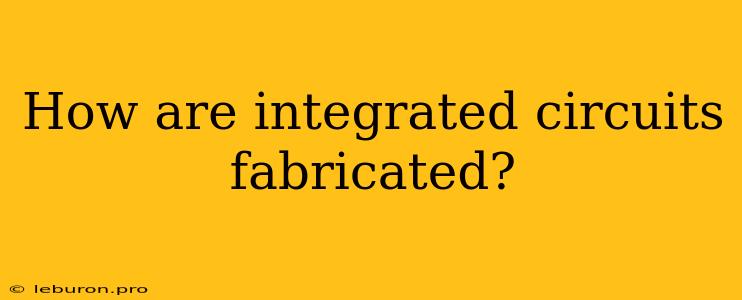The intricate world of electronics hinges on the remarkable ability to create integrated circuits, also known as microchips. These tiny silicon marvels pack billions of transistors onto a single chip, enabling the functionality of our computers, smartphones, and countless other devices. But how are these complex circuits fabricated? The process, known as semiconductor fabrication, is a multi-step, highly sophisticated procedure involving numerous specialized techniques. From the initial design to the final packaging, the journey of an integrated circuit is a testament to human ingenuity and technological prowess. This article delves into the fascinating world of integrated circuit fabrication, unraveling the secrets behind this complex process.
From Design to Reality: The Fabrication Journey
The creation of an integrated circuit is a meticulous process that starts with a blueprint—the circuit design. This design, typically created using specialized software, specifies the arrangement and interconnection of transistors, resistors, capacitors, and other components. The design is then translated into a series of fabrication masks, which act as stencils for each layer of the chip. These masks are used in the photolithography process, a crucial step in integrated circuit fabrication.
Photolithography: The Foundation of Chip Manufacturing
Photolithography, literally meaning "writing with light," is the cornerstone of integrated circuit fabrication. This technique involves transferring patterns from the masks onto the silicon wafer, the base material for the chip. The process begins with coating the wafer with a thin layer of photoresist, a light-sensitive material.
1. Exposure and Development: Creating the Pattern
The wafer is then exposed to ultraviolet (UV) light through the mask. The photoresist reacts to the UV light, becoming either soluble (positive photoresist) or insoluble (negative photoresist) depending on the type of photoresist used. The exposed areas are then developed, removing the soluble photoresist, leaving behind the desired pattern on the wafer.
2. Etching: Carving the Circuit
The photoresist pattern serves as a mask for etching, a process that removes unwanted material from the silicon wafer. Etching can be done using wet chemicals (wet etching) or reactive gases (dry etching). The etching process creates the intricate patterns of the integrated circuit.
Doping: Controlling Electrical Properties
After etching, the wafer undergoes doping, a process that introduces impurities into the silicon lattice. This controlled introduction of impurities modifies the silicon's electrical conductivity, creating areas of p-type (positive) and n-type (negative) conductivity. Doping allows the formation of transistors and other components within the integrated circuit.
Thin Film Deposition: Building Layers
The fabrication process often involves depositing thin films of various materials onto the wafer. These films can be deposited using techniques such as sputtering, evaporation, or chemical vapor deposition. Each deposited layer serves a specific function in the integrated circuit, such as insulation, electrical conductivity, or forming interconnections between components.
Interconnection: Connecting the Components
Once all the layers are deposited, they are interconnected using a process called metallization. This involves depositing thin films of conductive materials, typically aluminum or copper, onto the wafer. These metal layers form the wiring that connects the various components within the integrated circuit.
Packaging and Testing: The Final Steps
The fabricated wafer is then diced into individual chips, each containing a complete integrated circuit. These chips are then packaged in protective enclosures with pins for external connections. Finally, the packaged chips are subjected to rigorous testing to ensure their functionality and reliability.
The Future of Integrated Circuit Fabrication: Challenges and Advancements
As semiconductor technology continues to advance, so do the challenges of integrated circuit fabrication. One major challenge is the relentless drive towards miniaturization, as manufacturers strive to pack more transistors onto a single chip. This trend leads to challenges in controlling the manufacturing process at ever-smaller scales.
1. Advanced Lithography Techniques
To overcome these challenges, researchers are exploring new lithography techniques, such as extreme ultraviolet (EUV) lithography, which uses shorter wavelength light to achieve finer resolution.
2. Emerging Materials and Processes
The development of new materials and fabrication processes is another key area of research. These advancements aim to improve performance, reduce power consumption, and enhance the reliability of integrated circuits.
3. Artificial Intelligence and Automation
Artificial intelligence (AI) and automation are also playing an increasing role in integrated circuit fabrication. AI-powered systems can optimize processes, improve yield, and reduce manufacturing costs.
Conclusion
The fabrication of integrated circuits is a marvel of engineering and science, a testament to human ingenuity. From the initial design to the final packaging, the journey of an integrated circuit is a complex and fascinating process involving numerous specialized techniques. The relentless pursuit of miniaturization and innovation continues to drive advancements in integrated circuit fabrication, paving the way for even more powerful and sophisticated electronic devices in the future.
